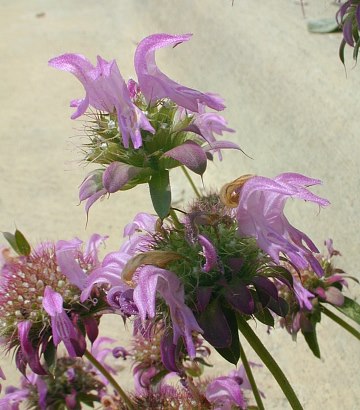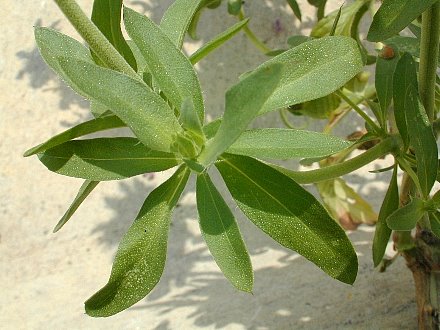
The central stem terminates into 2 or more whorls of flowers. Underneath each whorl of flowers, there is a whorl of floral bracts with a colorful leafy appearance. Individual flowers are about ¾" long, consisting of a light pink to purplish pink corolla that is deeply two-lipped, a green to purplish green tubular calyx with 5 teeth that terminate into conspicuous awns, and the reproductive organs (2 stamens & a pistil) that remain largely inserted within the corolla. The narrow upper lip of the corolla functions as a protective hood, while the narrow lower lip has 3 terminal lobes and functions as a landing pad for floral visitors. The upper lip is softly hairy at its apex. The corolla is not spotted, although it may have stripes within its interior. The teeth of the calyx are deltate-linear in shape; including the awns, they are at least 3 times longer than they are across. The floral bracts are about the same size as the true leaves. These bracts are about the same color as the corollas of the flowers (light pink to purplish pink, although with some greenish tints) and more or less oblong in
Cultivation: Lemon Bee Balm will adapt to full sun, mesic to dry conditions, and many kinds of soil, including clay-loam. In rich soil with abundant moisture, this wildflower may become excessively tall and topple over.
Range & Habitat: Lemon Bee Balm is not native to Illinois; it is either adventive from the Great Plains or western states, where it is native, or it is an escape from cultivation. As a naturalized plant, Lemon Bee Balm is rare in Illinois, where it has been found only in Cook County (within the NE section of the state). Habitat information is unavailable for Illinois, but in its native range this wildflower is found primarily in dry prairies. It is occasionally cultivated as an ornamental plant in gardens.
Faunal Associations: The nectar of the flowers can be expected to attract such visitors as the Ruby-throated Hummingbird, bumblebees, hummingbird clear-wing moths (Hemaris spp.), and butterflies. There is also some evidence that Checkered beetles (Cleridae) occasionally visit the flowers of Lemon Bee Balm (Mawdsley, 2002). Some insects feed on the foliage and flowers of Monarda spp. (Bee Balms) destructively. This includes caterpillars of such moths as the Gray Marvel (Anterastria teratophora; syn. Agriopodes teratophora), two Pyralid moths (Pyrausta orphisalis and Pyrausta signatalis), and the Hermit Sphinx (Sphinx eremitus). Other insect feeders include a tortoise beetle (Physonota unipunctata), a leaf-footed bug (Euthochtha galeator), a scentless plant bug (Arhyssus nigristernum), and an aphid (Hyalomyzus monardae). Mammalian herbivores dislike the fragrant foliage and avoid consumption of Lemon Bee Balm.
Photographic Location: A garden at the Urbana Free Library in Urbana, Illinois.

Comments: Lemon Bee Balm is an attractive, if short-lived, plant. Its foliage has a mild lemon or oregano fragrance. Lemon Bee Balm can be distinguished from most Monarda spp. (Bee Balms) in Illinois by its more narrow leaves, which are somewhat downy-pubescent, and by its annual or biennial habit. It resembles Monarda punctata (Spotted Bee Balm) somewhat, but the latter species has flowers with brown-spotted cream corollas, rather than unspotted pink corollas. Lemon Bee Balm also resembles Monarda pectinata (Plains Bee Balm), although this latter species has not naturalized in Illinois. Plains Bee Balm has floral bracts that taper gradually into awned tips, while the floral bracts of Lemon Bee Balm taper abruptly into awned tips. Both of these species have distinctive calyx teeth with long awns.